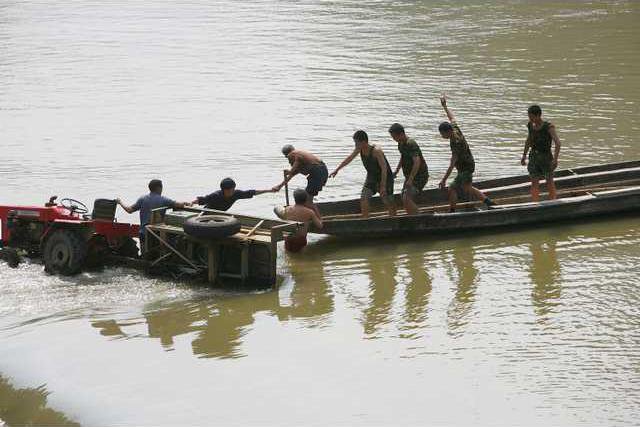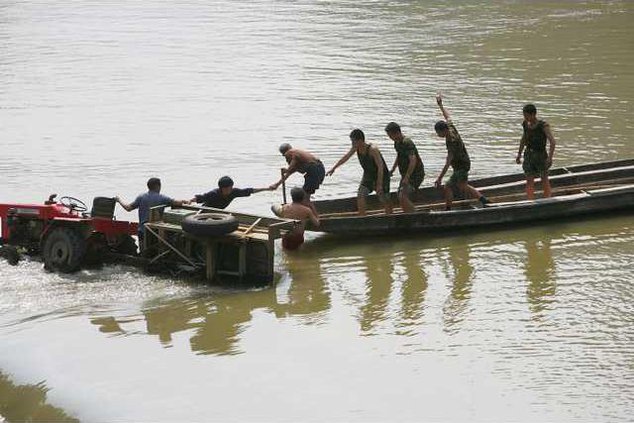MIANYANG, China — About 80,000 people were evacuated Tuesday from downstream of an unstable earthquake-created dam that is threatening to collapse, and troops rushed to carve a trench to drain the water before it floods the valley.
The threat of flooding from dozens of lakes swelling behind walls of mud and rubble that have plugged narrow valleys in parts of the disaster zone is adding a new worry for millions of survivors.
More than 30 villages were emptied and the people were being sent to camps like the one outside Jiangyou, where an Associated Press reporter saw 12-15 people crammed into each of about 40 government-issued tents pitched on a hillside overlooking the river.
‘‘We were told that so far it is the safest place for us to stay if the dam of the lake crashes,’’ said Liu Yuhua, whose village of Huangshi was one of those emptied. ‘‘But we will have to move farther uphill if the situation turns out to be worse.’’
Troops on Tuesday used explosives to blow up tree stumps that were hampering heavy-duty excavators that were airlifted by helicopter in recent days to the newly formed Tangjiashan lake near the town of Beichuan, the official Xinhua News Agency reported.
The magnitude-7.9 quake that struck Sichuan province May 12 sent a mass of dirt and rocks tumbling in the valley about two miles above the town in a spot not reached by roads, plugging a river that is now forming the lake.
Elsewhere in the region, workers also used explosives to level some buildings that were left teetering by the quake — a further sign that officials have stopped rescue and recovery efforts in some places.
The number of deaths from the quake climbed toward an expected toll of 80,000 or more. China’s Cabinet said Tuesday that 67,183 people were confirmed killed, with 20,790 still missing.
Aftershocks continued to rattle the region, causing more damage and injuries and jangling the already-frayed nerves of survivors. Two temblors Tuesday caused more than 420,000 houses to collapse in Qingchuan county, Xinhua reported. Sixty-three people were injured, including six who were critically hurt.
The U.S. Geological Survey measured a magnitude-5.2 aftershock just after 4 p.m. (4 a.m. EDT) and one measuring 5.7 about a half-hour later.
In a live broadcast, state television showed heavy earth-moving equipment being used to carve a 200-yard channel to drain the water from the Tangjiashan lake.
‘‘We are prepared to get rid of the trees by chopping and explosion. After that, the second batch of equipment will be moved in,’’ Liu Ning, chief engineer at the Ministry of Water Resources, was quoted as saying on CCTV.
Downstream, officials rushed to evacuate people in the path of potential floodwaters. Xinhua said emergency workers labored into the night to try to get 80,000 people out. Another group of about 80,000 have already been moved out of the valley, it said.
At Tangjiashan lake, hundreds of troops were working around the clock to dig a channel that would divert the rising waters before they breach the top of the rubble wall. Officials fear the loose soil and debris wall could crumble easily if the water starts cascading over the top, and send a torrent flooding down into the valley.
The lake now holds 34 billion gallons of water and was rising by more than 3 feet every 24 hours, Xinhua reported.
Tangjiashan is the largest of some 35 lakes created by rubble blocking rivers in the quake zone. Some rising floodwaters have already swallowed villages, though only Tangjiashan was posing a risk of another big catastrophe.
Adding to the urgency, thunderstorms were forecast for parts of Sichuan this week — a foretaste of the summer rainy season that accounts for more than 70 percent of the 24 inches of rain that falls on the area each year.
Man-made dams in the mountainous region were also weakened by the quake, although officials said there is no major threat.
At one dam site near the town of Mianyang, villagers workings in nearby rice fields said cracks had appeared in the dam wall after the quake but that government workers had reinforced it with steel rods.
In the town of Yingxiu, explosives were used to demolish some damaged buildings, a new element to the massive cleanup operation. Teams have been pulling down creaky buildings across Sichuan using mostly excavators, bulldozers and other heavy machinery.
Also Tuesday, health officials said higher-than-normal rates of stomach pains and fever had been reported among the millions of quake survivors, but that no major disease outbreaks had occurred.
About 5 million people were left homeless by the quake, and many are living in tents or makeshift camps clustered throughout the disaster zone.
Qi Xiaoqiu, the director of disease prevention at the Health Ministry, said the quake had knocked out much of the region’s health infrastructure. He said 12 field hospitals had been erected and tens of thousands of health professionals sent into the zone.
‘‘With the destruction by the quake, the living and sanitary conditions have worsened for the local population,’’ Qi said in Beijing. ‘‘Their physical conditions are weakened, (they are) more vulnerable to disease.’’
Diseases such as tuberculosis, hepatitis and diarrhea remained a threat, but so far no outbreaks had been reported, he said.
The threat of flooding from dozens of lakes swelling behind walls of mud and rubble that have plugged narrow valleys in parts of the disaster zone is adding a new worry for millions of survivors.
More than 30 villages were emptied and the people were being sent to camps like the one outside Jiangyou, where an Associated Press reporter saw 12-15 people crammed into each of about 40 government-issued tents pitched on a hillside overlooking the river.
‘‘We were told that so far it is the safest place for us to stay if the dam of the lake crashes,’’ said Liu Yuhua, whose village of Huangshi was one of those emptied. ‘‘But we will have to move farther uphill if the situation turns out to be worse.’’
Troops on Tuesday used explosives to blow up tree stumps that were hampering heavy-duty excavators that were airlifted by helicopter in recent days to the newly formed Tangjiashan lake near the town of Beichuan, the official Xinhua News Agency reported.
The magnitude-7.9 quake that struck Sichuan province May 12 sent a mass of dirt and rocks tumbling in the valley about two miles above the town in a spot not reached by roads, plugging a river that is now forming the lake.
Elsewhere in the region, workers also used explosives to level some buildings that were left teetering by the quake — a further sign that officials have stopped rescue and recovery efforts in some places.
The number of deaths from the quake climbed toward an expected toll of 80,000 or more. China’s Cabinet said Tuesday that 67,183 people were confirmed killed, with 20,790 still missing.
Aftershocks continued to rattle the region, causing more damage and injuries and jangling the already-frayed nerves of survivors. Two temblors Tuesday caused more than 420,000 houses to collapse in Qingchuan county, Xinhua reported. Sixty-three people were injured, including six who were critically hurt.
The U.S. Geological Survey measured a magnitude-5.2 aftershock just after 4 p.m. (4 a.m. EDT) and one measuring 5.7 about a half-hour later.
In a live broadcast, state television showed heavy earth-moving equipment being used to carve a 200-yard channel to drain the water from the Tangjiashan lake.
‘‘We are prepared to get rid of the trees by chopping and explosion. After that, the second batch of equipment will be moved in,’’ Liu Ning, chief engineer at the Ministry of Water Resources, was quoted as saying on CCTV.
Downstream, officials rushed to evacuate people in the path of potential floodwaters. Xinhua said emergency workers labored into the night to try to get 80,000 people out. Another group of about 80,000 have already been moved out of the valley, it said.
At Tangjiashan lake, hundreds of troops were working around the clock to dig a channel that would divert the rising waters before they breach the top of the rubble wall. Officials fear the loose soil and debris wall could crumble easily if the water starts cascading over the top, and send a torrent flooding down into the valley.
The lake now holds 34 billion gallons of water and was rising by more than 3 feet every 24 hours, Xinhua reported.
Tangjiashan is the largest of some 35 lakes created by rubble blocking rivers in the quake zone. Some rising floodwaters have already swallowed villages, though only Tangjiashan was posing a risk of another big catastrophe.
Adding to the urgency, thunderstorms were forecast for parts of Sichuan this week — a foretaste of the summer rainy season that accounts for more than 70 percent of the 24 inches of rain that falls on the area each year.
Man-made dams in the mountainous region were also weakened by the quake, although officials said there is no major threat.
At one dam site near the town of Mianyang, villagers workings in nearby rice fields said cracks had appeared in the dam wall after the quake but that government workers had reinforced it with steel rods.
In the town of Yingxiu, explosives were used to demolish some damaged buildings, a new element to the massive cleanup operation. Teams have been pulling down creaky buildings across Sichuan using mostly excavators, bulldozers and other heavy machinery.
Also Tuesday, health officials said higher-than-normal rates of stomach pains and fever had been reported among the millions of quake survivors, but that no major disease outbreaks had occurred.
About 5 million people were left homeless by the quake, and many are living in tents or makeshift camps clustered throughout the disaster zone.
Qi Xiaoqiu, the director of disease prevention at the Health Ministry, said the quake had knocked out much of the region’s health infrastructure. He said 12 field hospitals had been erected and tens of thousands of health professionals sent into the zone.
‘‘With the destruction by the quake, the living and sanitary conditions have worsened for the local population,’’ Qi said in Beijing. ‘‘Their physical conditions are weakened, (they are) more vulnerable to disease.’’
Diseases such as tuberculosis, hepatitis and diarrhea remained a threat, but so far no outbreaks had been reported, he said.

